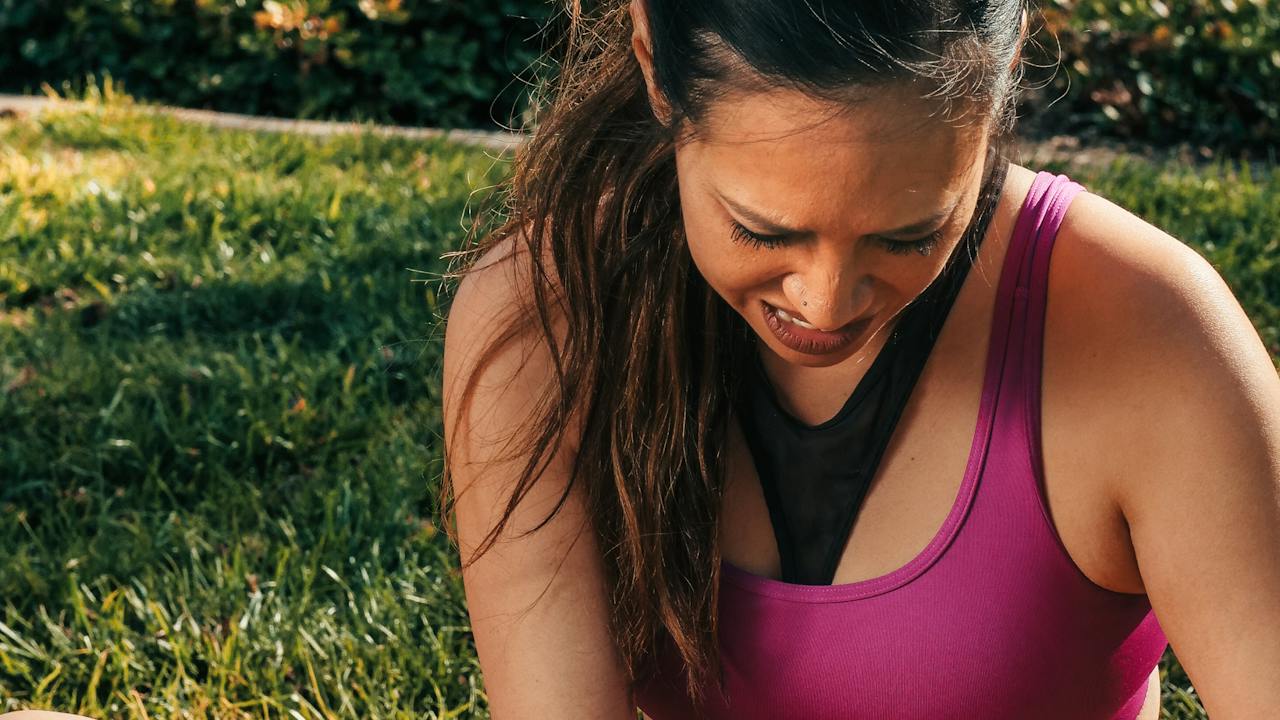Yoga for Knee Pain: Benefits of Stretching And Strengthening
Discover yoga for knee pain, an effective and non-invasive way of easing distressing symptoms. Learn how these poses help improve mobility, flexibility, and pain tolerance.
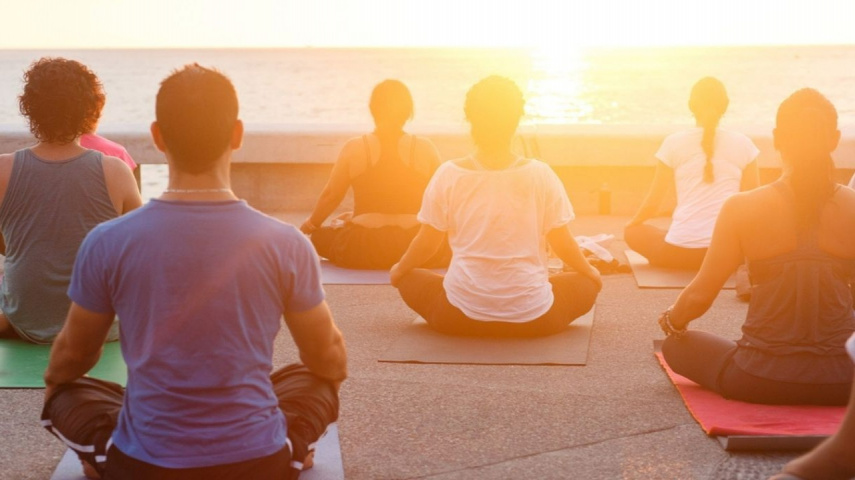
Knee pain is a medical condition that can impact people from any age group, leading to distressful symptoms and limiting one’s movement and functions. Therefore, we are here to discuss yoga for knee pain — a solution that is not only simple but does not require invasive and drug therapies. Sometimes knee pains are mild or self-limiting, but on the other hand, these might be indications of serious health-related issues that require medical attention. So, it is essential to consult a healthcare provider before you self-medicate, as it may worsen the condition.
Yoga, as we all know, is an age-old Indian cultural practice that aims at healing the mind, body, and soul alike. It is believed that the three elements are interlinked, and therefore targeting all three parts helps offer a holistic solution, unlike traditional medications. Yoga involves a wide array of types, poses, and exercises which are aimed at providing different benefits. So, let us explore how some of these poses can be surprisingly effective in alleviating knee pain and its associated symptoms.
What Are The Causes of Knee Pain?
Knee pain is a common condition characterized by discomfort, soreness, or pain in the knee joint. The severity and nature of knee pain can vary, and it may be caused by various factors. Although the primary symptom is pain, people may experience some other common symptoms of knee pain, including swelling, inflammation, stiffness, weakness, and difficulty walking. This condition may occur due to several different reasons, which can be both intrinsic and extrinsic. Let us discuss some of the common causes of knee pain:
- Osteoarthritis: This is commonly an age-related condition in which gradual wear and tear of the knee joint's cartilage can lead to osteoarthritis, resulting in joint pain, stiffness, bone swelling, and reduced joint mobility (1).
- Rheumatoid Arthritis: It is an inflammatory and autoimmune condition in which the body’s immune system targets its own bone, cartilage, and ligament cells as foreign entities and kills them. Therefore, it slowly leads to weakness, pain, swelling, and inflammation (2).
- Injuries: Traumatic injuries such as ligament sprains, muscle strains, meniscus tears, or fractures can lead to knee pain (3).
- Infections Or Inflammation: Inflammation or irritation of the tendons around the knee, like patellar tendonitis (jumper's knee) can also cause knee pain. Moreover, infections in or around the knee joint can cause pain and require medical treatment (3).
- Bursitis: The Bursa is a sac filled with fluid that adds a cushioning effect to the major joints such as the shoulder, knee, hips, and elbows to reduce friction. When these get inflamed, it leads to painful conditions where the affected joint experiences stiffness and swelling, called bursitis (4).
- Overuse of Muscles: Activities that involve repetitive motions or excessive strain on the knees, such as running or cycling, can lead to overuse injuries and knee pain (3).
- Obesity: Excess body weight can put additional stress on the knee joints, leading to pain and increasing the risk of other knee problems (5).
- Gout: This medical condition is a type of chronic inflammatory arthritis caused by the accumulation of uric acid crystals in the knee joint, resulting in sudden and severe pain (6).
- Iliotibial Band Syndrome (ITBS): This is another inflammatory condition that affects the iliotibial band, a thick band of tissue that runs from the hip to the outer side of the knee (7).
- Alignment Issues: Poor alignment of the knee joint, often due to issues with the feet or hips, can lead to knee pain over time.
Benefits of Doing Yoga for Knee Pain
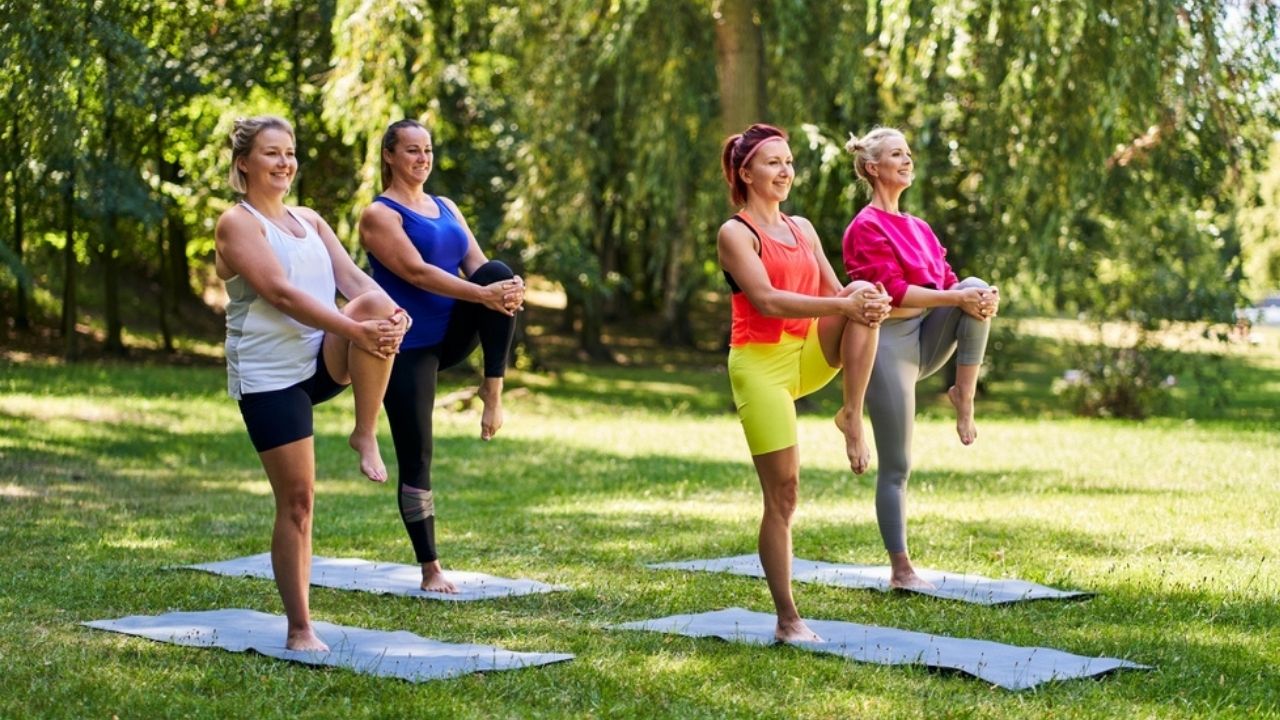
Yoga for knee pain can help the condition in several different ways. It includes poses that allow you to stretch and focus on breathing which gradually reduces the intensity of the symptoms or increases your pain endurance. So here are some of the benefits yoga can offer for your knee pain:
- Improved Strength And Flexibility: Yoga poses for knee pain gently strengthen the muscles around the knee and increase joint flexibility, which can help reduce pain and improve mobility (8).
- Enhanced Joint Stability: Certain yoga poses focus on balance and stability, which can aid in stabilizing the knee joint and reducing the risk of injuries (8).
- Pain Management: Yoga's mindful approach to movement and breathing can help alleviate chronic knee pain and provide relief from discomfort (9).
- Better Posture: Yoga encourages proper alignment and posture, which can alleviate strain on the knees and promote long-term knee health (8)
- Stress Reduction: Reducing stress through yoga practices can help relax tense muscles and reduce inflammation, which often contributes to knee pain (9)
- Weight Management: Maintaining a healthy weight through yoga can ease the load on the knees, potentially reducing pain caused by excess body weight (10).
- Improved Circulation: Yoga poses that include bending have been proven to boost circulation by strengthening cardiac muscles. Yoga postures also include breathing practices which can also promote blood flow. Therefore, with an increased circulation of blood to the knee joint, healing and recovery may become faster and more efficient (11).
- Prevention: Regular yoga practice at an early age can also help delay aging-related knee and other health issues by improving overall body awareness and balance. Moreover, a strengthened core and better posture achieved by practicing yoga for knees also prevent future knee injuries (12).
6 Best Yoga Poses for Knee Pain
Now that we understand how yoga can help in alleviating painful symptoms associated with knee pain, let us check out the various poses you can practice in order to experience the benefits:
1. Extended Triangle Pose (Trikonasana):
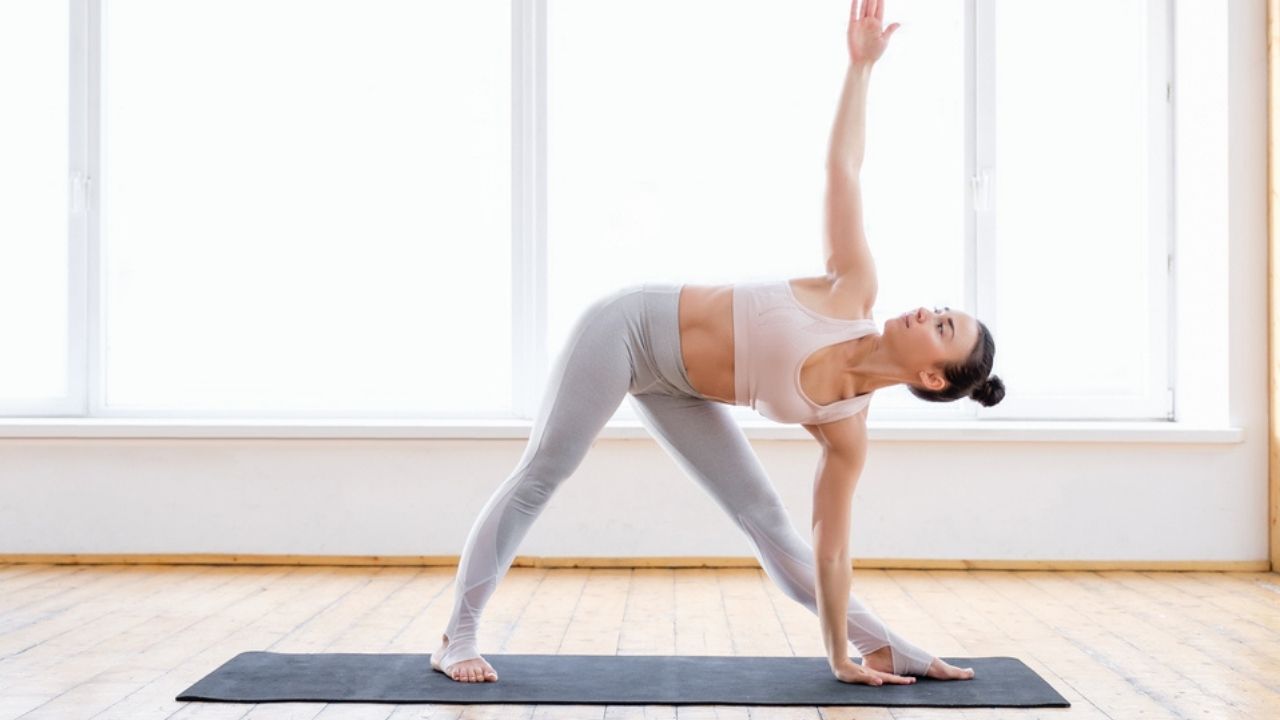
Trikonasana stretches and strengthens the legs, reducing knee pain and improving overall leg stability.
Instructions:
- Begin by standing at the top of your yoga mat with your feet about 3-4 feet apart. Your feet should be parallel to each other.
- Turn your right foot out 90 degrees so it points to the right side of your mat. Your left foot can be slightly turned inwards, about 15 degrees.
- Inhale and engage your core. As you exhale, begin to reach your torso and upper body over your right leg.
- Keep your spine long and extended, and avoid rounding your back. Your goal is to create a triangular shape with your body.
- Place your right hand on your shin, ankle, or the floor, just outside your right foot. Avoid putting excessive pressure on the knee.
- Extend your left arm up toward the ceiling, creating a straight line from your left foot to your left hand.
- Keep your gaze on your left fingertips. Breathe deeply and hold the pose for a few breaths, feeling the stretch along your right side.
- To come out of the pose, engage your core, inhale, and slowly return to an upright position. Repeat the pose on the other side.
2. Bridge Pose (Setu Bandha Sarvangasana):
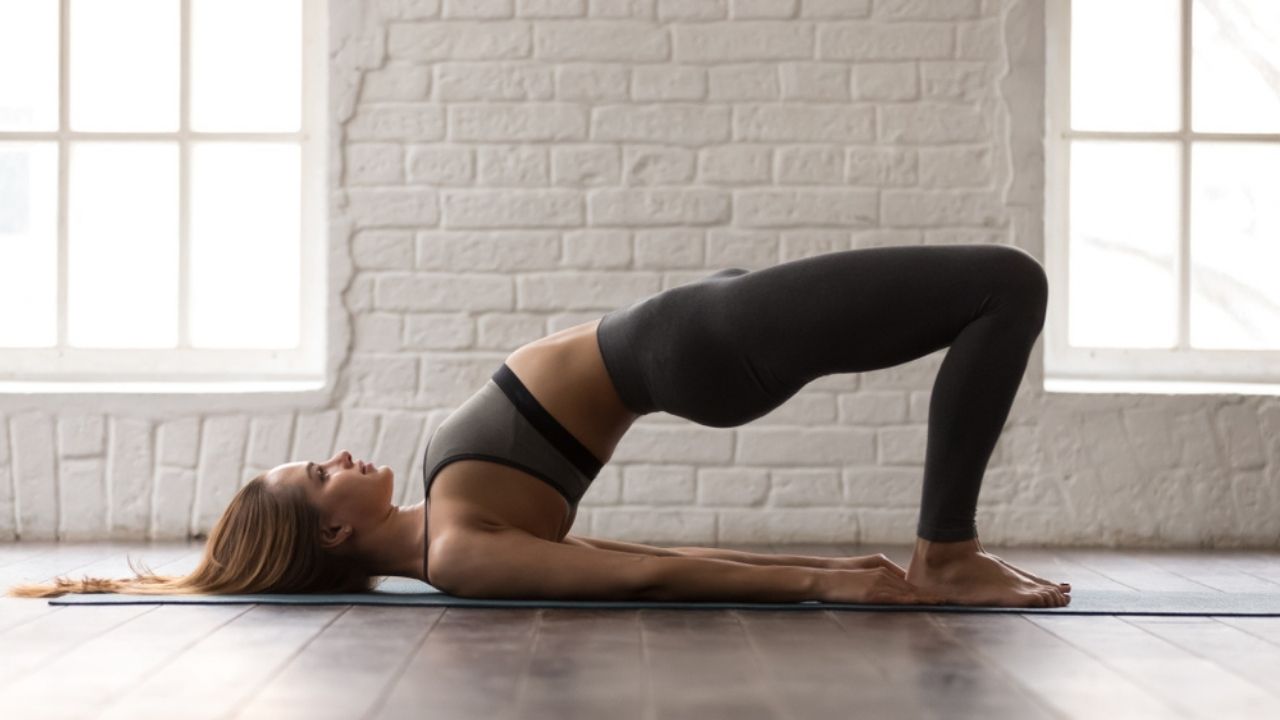
It is an ideal yoga for knee injury posture which strengthens the muscles around the knees and thighs while stretching the hips and lower back.
Instructions:
- Begin by lying on your back on a yoga mat with your knees bent and feet flat on the floor. Keep your feet hip-width apart. Place your arms alongside your body with your palms facing down.
- Ensure that your feet are directly under your knees, and your ankles are aligned with your knees. This helps maintain proper alignment.
- Inhale, press through your feet, and engage your glutes and core muscles. Slowly lift your hips off the ground, raising your pelvis toward the ceiling.
- Continue to lift your hips and roll your spine off the floor, one vertebra at a time. Keep your weight evenly distributed between your feet and shoulders.
- Once your hips are lifted, you can interlock your hands beneath your pelvis. This can help provide additional support and stability to the pose.
- Hold the bridge pose for several breaths, making sure to keep your neck and head relaxed on the mat. Maintain a straight line from your shoulders to your knees.
- To come out of the pose, gently release your hands, lower your spine down to the mat, and lower your hips back to the ground one vertebra at a time.
3. Child's Pose (Balasana):
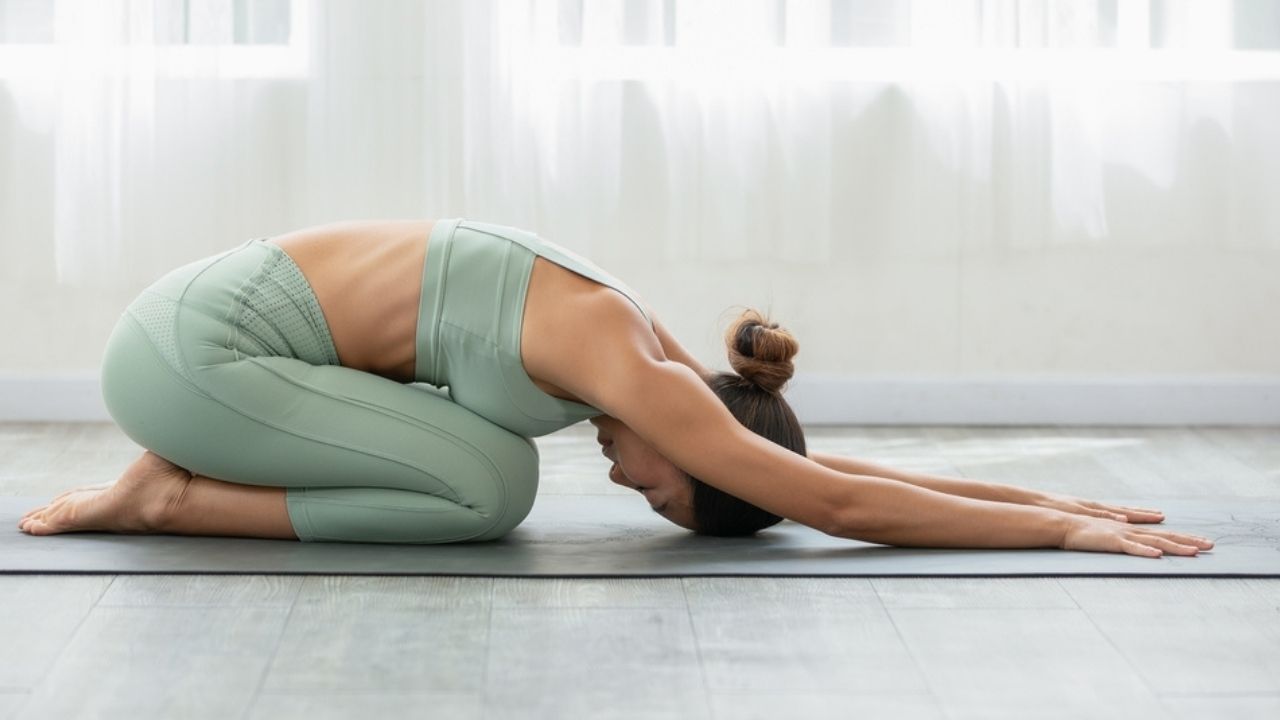
Balasana is a resting pose that stretches the knees and helps reduce tension in the joints.
Instructions:
- Start by kneeling on the floor with your knees hip-width apart and your big toes touching behind you.
- Sit back on your heels and take a moment to find a comfortable position. You can adjust the width of your knees as needed for comfort.
- As you inhale, elongate your spine, reaching your arms overhead.
- Exhale and slowly lower your upper body down, extending your arms forward on the mat. Your forehead should come to rest on the floor.
- Keep your arms active by reaching them forward, and gently pressing your palms, fingers, and the base of your fingers into the mat.
- Take deep breaths, relax in this posture, and hold it for as long as it's comfortable. Child's pose is a resting pose in yoga, so focus on your breath and use it to release any tension or stress.
- When you're ready to come out of the pose, gently walk your hands back toward your body and sit up.
4. Supported Hero Pose (Supta Virasana):
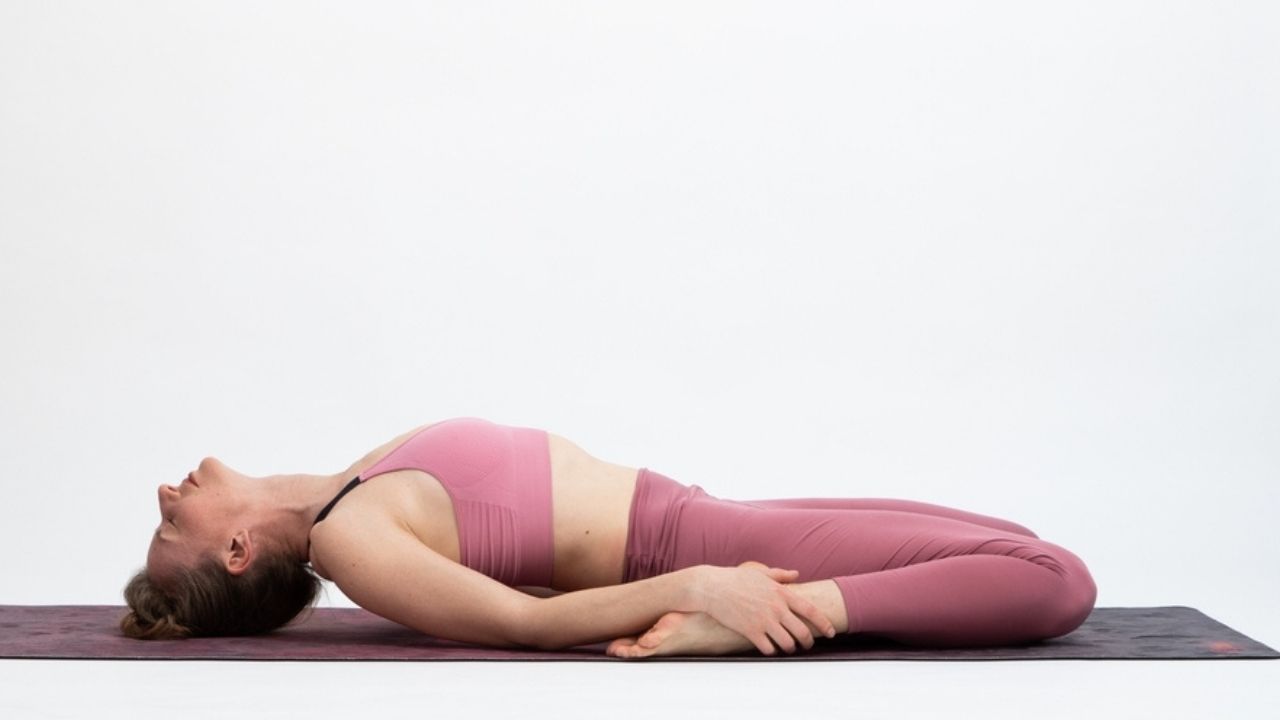
Supta Virasana gently stretches and opens the quadriceps and knees while promoting relaxation.
Instructions:
- Start by kneeling on the floor with your knees together and your feet apart, big toes touching. Your shins should be parallel to each other.
- Sit back on your heels. If you find this position uncomfortable, you can use a cushion, yoga block, or folded blanket to sit on. This additional support will lift your hips and reduce strain on the knees and ankles.
- Once you are seated comfortably on your heels or the support, ensure that your toes are pointing backward and your feet are relaxed.
- With your hands on your thighs, take a moment to lengthen your spine and relax your shoulders.
- You can stay in this position, or for a deeper stretch, gently lean backward, lowering your upper body towards the floor. Place your hands on the floor behind you for support.
- Relax in this reclined position, extending your arms by your sides. Breathe deeply and hold the pose for as long as it feels comfortable, gradually working on increasing your flexibility.
5. Seated Forward Bend (Paschimottanasana):
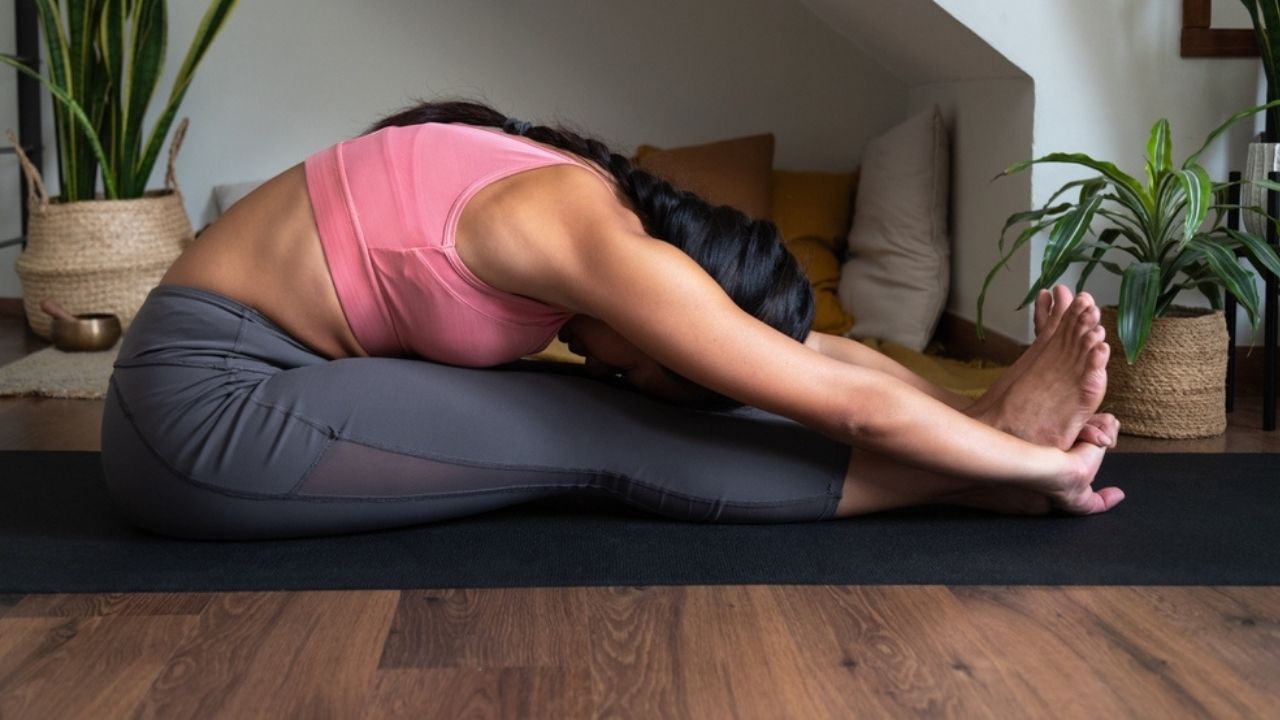
Paschimottanasana stretches the hamstrings and calves, providing relief to the knee joints.
Instructions:
- Begin by sitting on the floor with your legs extended straight in front of you. Ensure that your feet are flexed, your spine straight and your toes are pointing upward.
- Inhale as you raise your arms overhead, reaching toward the ceiling. Lengthen your spine and engage your core muscles.
- As you exhale, hinge at your hips to bend forward from your pelvis. Keep your back straight and lead with your chest, not your head. Reach for your toes or ankles.
- Hold onto your shins, ankles, or feet, depending on your flexibility. You can use a yoga strap if you can't reach your feet comfortably.
- Once you've reached your maximum stretch, focus on lengthening your spine with each inhale. As you exhale, try to deepen the stretch by gently pulling yourself closer to your legs.
- To come out of the pose, release your grip and slowly sit up with a straight back. Take a few breaths in this seated position, and then relax.
6. Chair Pose (Utkatasana):
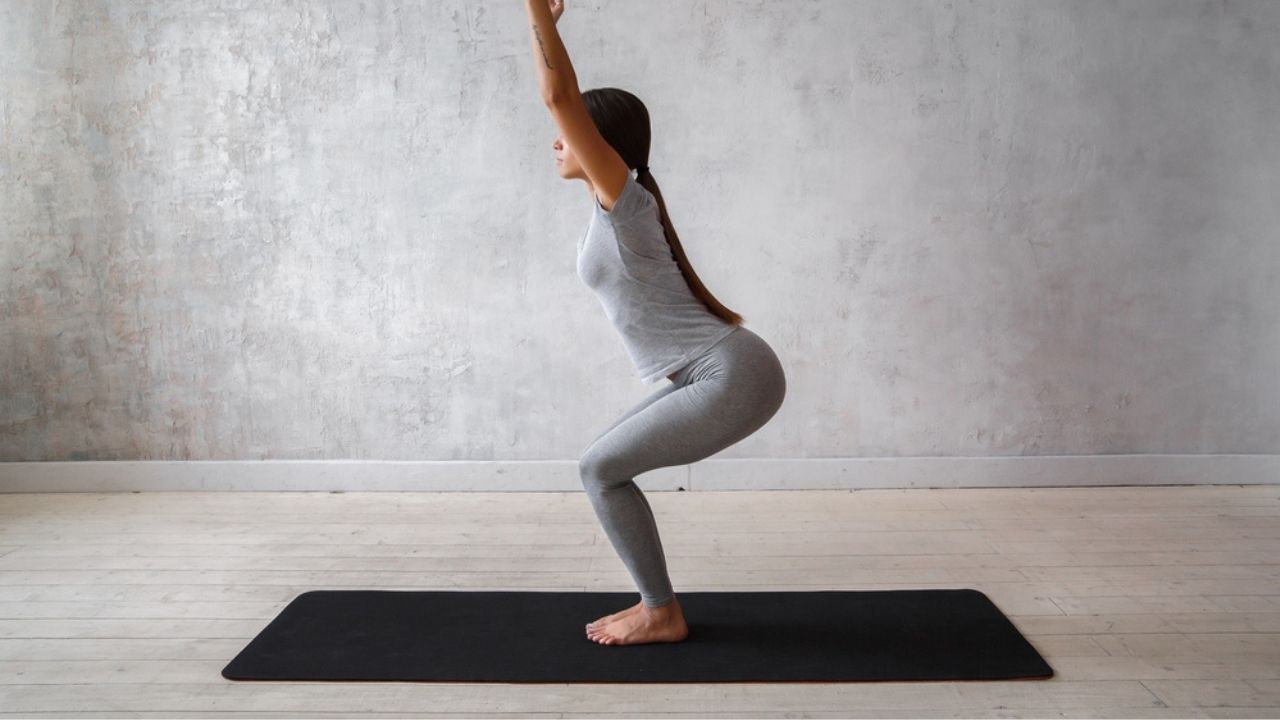
It is a standing posture that is one of the best yoga poses for knees which helps strengthen the legs and improve balance.
Instructions:
- Stand tall with your feet together and your arms at your sides.
- Inhale and raise your arms overhead, keeping them parallel and shoulder-width apart. Your palms can be facing each other or pressed together.
- Exhale as you bend your knees and lower your hips as if you're sitting back in an imaginary chair. Keep your knees in line with your ankles.
- Ensure your weight is evenly distributed between your heels and the balls of your feet.
- Your shins should be perpendicular to the floor, and your knees should not extend beyond your toes.
- Tilt your torso slightly forward, engaging your core muscles to maintain a straight back. Lift your chest and keep your spine lengthened.
- Your arms can remain extended overhead or bring your palms together in front of your chest.
- Hold for several breaths, working on deepening your bend if possible.
Conclusion
Yoga for knee pain is not only a treatment procedure but also a holistic lifestyle change that will help assuage the symptoms and prevent further injuries. It includes postures that allow you to stretch strained ligaments, massage the joints, and manage pain. Moreover, yoga induces blood flow to the targeted area, which improves and quickens the healing process. From simple beginner-friendly poses of yoga for bad knees like chair and child’s pose to intermediate postures like bridge and seated bend poses, this article caters to the needs of all individuals who are suffering from knee pain. However, since knee pain is a clinical issue and can get aggravated by wrongful treatments, it is advisable to seek advice from healthcare providers and yoga experts before beginning your healing journey.
ALSO READ: Yoga for Kidney Stones: Soothe Your Symptoms Mindfully





 JOIN OUR WHATSAPP CHANNEL
JOIN OUR WHATSAPP CHANNEL



















































































